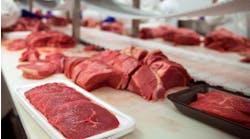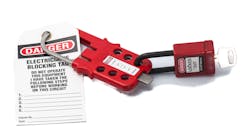A dirty rag, casually tossed aside. A faulty wire you never got around to replacing. A long-ignored fire extinguisher collecting dust in a corner. Sometimes it’s hard to believe such mundane items can lead to catastrophic fires, but unfortunately, that’s often the case. So when it comes to preventing fires at your food processing facilities, that’s where you ought to focus: Cleanliness. Maintenance. Common sense.
Start by assessing your current operations with a few simple questions:
- Are you actively working to prevent a fire in your building—or have you just been lucky so far?
- Do you routinely inspect, maintain and update your electrical, roof and HVAC systems?
- Do you follow safety procedures for recharging batteries, especially overnight?
- What practices do you follow when storing flammables, vapors and combustible dusts?
From there, review your fire safety program in greater detail. The following areas are particularly relevant:
Smoking
Smoking can be a fraught subject for employers, employees and customers. But it’s essential that you take it seriously and define your plan clearly. Many businesses prohibit smoking inside their buildings but allow it in a designated exterior location—though in recent years, we’ve noticed an increasing number of businesses prohibiting smoking on their campuses altogether. If you choose to allow smoking in a designated area, start by making sure the area is clearly marked. Remove any fire hazards, and provide approved receptacles for the cigarette butts. After all, an errant cigarette butt can do far worse than making your parking lot look dirty.
Flammable materials
If you use or store flammable materials at your facility, such as rags, flours and powdered ingredients, establish safety guidelines—including handling and storage—based on recommendations from your suppliers. While these rules will vary based on the types of materials you’re dealing with, arguably the most important rule is also the most obvious: Keep potential ignition sources away from flammables.
Sprinklers and fire suppression equipment
A functioning sprinkler system stands as one of your most effective fire deterrents, stopping or minimizing potentially disastrous fires before they spread. A malfunctioning or outdated sprinkler system, on the other hand, can lead to a false sense of security and a host of additional—often costly—problems. Have your sprinkler system inspected and tested regularly, either by a qualified member of your team or by an outside professional, to effectively protect your premises.
Electrical systems
Approach your electrical system maintenance with the same mindset. While its day-to-day usage obviously differs in comparison to your fire suppression system, your electrical system can have a similar impact on your fire risk. Have a qualified electrician inspect your electrical system every five years, at minimum, and your heating system at least every two years.
Additional actions
You should customize your fire safety program to best suit your business. That said, there are several key fire prevention strategies all food processors should adopt:
- Equip your water and heating systems with timer controls to prevent machinery from operating while the building is unattended.
- Use high-temperature shutoff controls to isolate machinery and energy sources if the operating temperature exceeds a safe range.
- Inspect oil heating and venting components regularly to prevent flammable residue.
- Maintain appropriate extinguishing systems to address high-risk operations such as frying.
- Isolate after-hours battery-charging stations to safe locations outside the building.
A culture of safety
On a final note, I want to emphasize something crucial—something I’ve seen companies ignore, something that can lead to the exact situations they were trying to avoid. While annual or semi-annual inspections are vital, they shouldn’t be viewed as an excuse for ignoring routine maintenance. A lot can happen over the course of several years.
Work with your leadership team to ensure they fully support these practices. Because ultimately, fire prevention begins with you. Take it upon yourself to assess your current fire safety plan honestly and critically, and—with the strategies I’ve outlined above—shore up any weaker areas. When your employees see you and your fellow leaders taking this topic seriously, they’ll follow suit. That’s how you create a culture of safety.
About the Author: Troy Tepp, CSP, is the Director of Safety Services with Sentry Insurance. Troy’s team of safety consultants helps Sentry customers apply safety and risk management practices to actively prevent the catastrophic effects of fires in their business operations.
Property and casualty coverages are underwritten, and safety services are provided, by a member of the Sentry Insurance Group, Stevens Point, WI. For a complete listing of companies, visit sentry.com. Policies, coverages, benefits, and discounts are not available in all states. See policy for complete coverage details.


